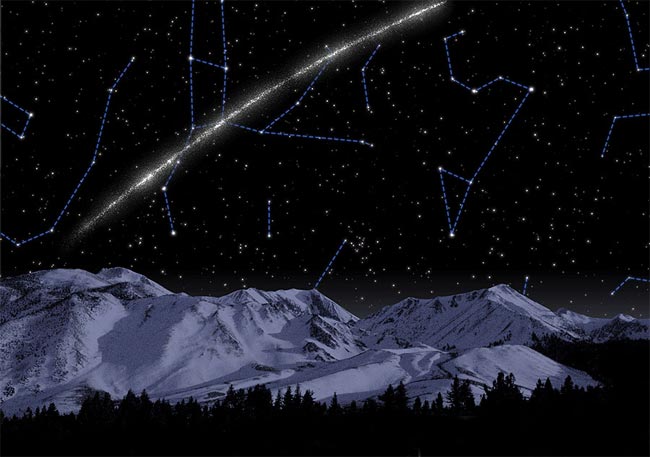Startling Galactic Highway Found in Milky Way

CALGARY, ALBERTA--A newly detected stream of stars festoons the northern sky in a sweeping arc that cuts across the entire constellation of Ursa Major (through the Big Dipper), from just above the head of Leo the lion to the constellation Cancer the crab.
Although it spans fully 63 degrees (one-third of the northern celestial hemisphere), the star stream escaped notice until now because its individual stars are far too faint to see with the naked eye. Also, they don't jump out as a readily discernible shape or pattern, like a cluster or constellation, amid the surrounding star fields.
To snare this star stream, astronomers Carl Grillmair and Odysseas Dionatos used a clever combination of available photometric data (precise measurements of the relative brightness and colors of stars) and ingenious computer modeling to tease out the trace of a long, narrow arc of stars from the stellar foreground "noise."
"It took a lot of patience," Grillmair told SPACE.com here last week during the 208th meeting of the American Astronomical Society. What emerged eventually was the startling shape of a "galactic highway" that loops above the disk of the Milky Way.
Grillmair, a research scientist at the California Institute of Technology's Spitzer Science Center in Pasadena, believes the newly discovered galactic star stream stems from an ancient, or perhaps still existing, globular cluster, a tightly bunched collection of tens of thousands of stars.
About 150 such clusters are known to exist in the Milky Way's halo population.
Repeated passes close to the enormous gravity of the galactic core over the course of perhaps 12 billion years, said Grillmair, could have caused tidal disruptions in the cluster that gradually stripped its stars until they stretched out along the cluster's orbital path into a narrow stream averaging just half a degree in width along the 63-degree arc of about 2,000 stars detected thus far.
Breaking space news, the latest updates on rocket launches, skywatching events and more!
Grillmair and Dionatos used data from the Sloan Digital Sky Survey to make their find.
"What we can see of the stream is over 30,000 light-years long. It may actually be much longer, since we are currently limited by the extent of the survey data," says Grillmair. "I would actually be somewhat surprised if the stream doesn't extend completely around the Galaxy."
This discovery, Grillmair notes, "gives new weight to a theory that the Milky Way may once have been swarming with thousands of giant star clusters." If so, "there may be hundreds or even thousands of such stellar streams ringing our Galaxy. It's possible that globular clusters start being stripped of their stars by galactic tidal forces as soon as they're born. In that case, all globular clusters should have at least tiny tidal streams coming out of them, and I have actually found some."
Observing a tidal star stream, Gillmair notes, can tell us much about the distribution of dark matter in our Galaxy. "It's galactic dark matter that holds the stream in its orbit, keeping its stars from escaping the Galaxy altogether." But the smooth (rather than clumpy) shape of the star stream, he says, probably indicates that the Milky Way's dark matter is not concentrated into "gigantic chunks."
This is the third such tidal stream Gillmair has co-discovered. He now looks forward to being able to study such streams in greater detail when future instruments like the planned Space Interferometry Mission become available.
- The New Tourist's Guide to the Milky Way
- The New Milky Way: Bird's Eye View and Other Fresh Insights
- Cosmic Orphans: Stray Stars Found Wandering Between Galaxies
- Nearest Galaxy Ripped from Another, Study Suggests
Join our Space Forums to keep talking space on the latest missions, night sky and more! And if you have a news tip, correction or comment, let us know at: community@space.com.
